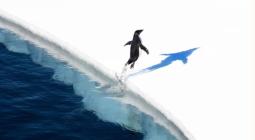Ocean fungi from twilight zone could be source of next penicillin-like drug
Largest study of ocean DNA reveals abundance of fungi thriving in extreme environment of the deep sea
Large numbers of fungi have been found living in the twilight zone of the ocean, and could unlock the door to new drugs that may match the power of penicillin.
The largest ever study of ocean DNA, published by the journal Frontiers in Science, has revealed intriguing secrets about the abundance of fungi in the part of the ocean that is just beyond the reach of sunlight. At between 200 metres and 1,000 metres below the surface, the twilight zone is home to a variety of organisms and animals, including specially adapted fish such as lantern sharks and kitefin sharks, which have huge eyes and glowing, bioluminescent skin.
“Penicillin is an antibiotic that originally came from a fungus called Penicillium so we might find something like that from these ocean fungi,” said Fabio Favoretto, a postdoctoral scholar at the Scripps Institution of Oceanography at the University of California, San Diego. The twilight zone is characterised by high pressure, a lack of light and cold temperatures, which presents an extreme environment “where fungi might exhibit unique adaptations”, he added. “That could potentially lead to the discovery of new species with unique biochemical properties.”
The new ocean DNA catalogue, launched on Tuesday, contains more than 317m marine organism gene groups compiled from samples collected on voyages including the four-year Tara Oceans expedition which started in 2009, and the 2010 Malaspina Circumnavigation expedition.
Advances in technology meant existing samples could provide much more data than before, while the process of cataloguing helped open new doors into the understudied ocean, said the marine biologist and the paper’s lead author, Elisa Laiolo.
The marine biotechnology sector, which relies on ocean organisms and their genes, is worth an estimated $6bn, a figure expected to almost double by 2032.
Laiolo was surprised to see so many fungi living in the ocean’s twilight zone. “There have been some indications of it [fungi abundance at this level] before, so this is another piece of the puzzle.”
Another critical discovery made during the cataloguing process, said Carlos Duarte, a marine science professor and senior author of the study, was the role viruses played in boosting gene diversity. “The viruses insert themselves and move genes from one organism to another. That means viruses create genomic biodiversity and that accelerates their evolution.”
One result of that acceleration, he said, were genes that had evolved to enable organisms to chew through plastic. “They can degrade synthetic polymers, derived from hydrocarbons, which are very recent as a pollutant in the ocean, showing that evolution happened in a few decades.”
The catalogue also highlighted gaps in our understanding of the ocean floor, said Laiolo. “It is easier to sample the water than the ocean floor and what we underline in the paper is the need to increase studies targeting the seabed in the future.”
Developments in supercomputing and sequencing technologies, she said, means more information can be gleaned from existing samples, at much lower costs.
Despite the catalogue’s benefits, Duarte said there were problems with marine gene ownership and sharing of the benefits, particularly with countries in the global south that lacked the same access to gene-sequencing and analytical supercomputing. “Currently, 10 nations own 90% of marine gene patents, the benefits are not being shared,” he said.
Changes to ownership rules are being made, however. “Since October last year a new treaty came into force that says those that discover a marine gene, own it.” said Duarte. “But they have to share the benefits. The problem is, it’s not clear how that benefit sharing is going to work.”
The catalogue’s release was welcomed by marine scientists. Favoretto described it as a “remarkable resource for biodiversity assessment and conservation efforts” that would enable researchers to monitor changes in species distribution, particularly in relation to the impact of the climate crisis and human activities.
Cover photo: The twilight zone is the part of the ocean just beyond the reach of sunlight. Photograph: Alexis Rosenfeld/Unesco





